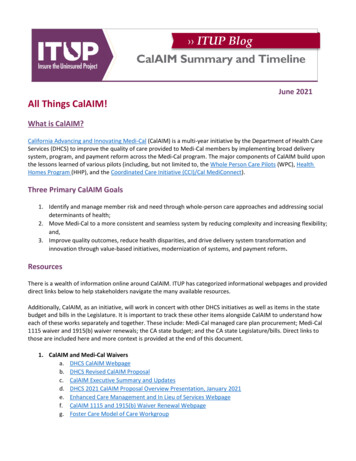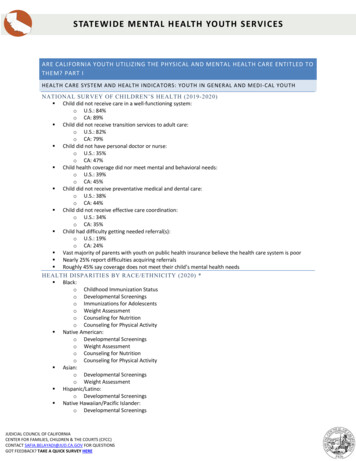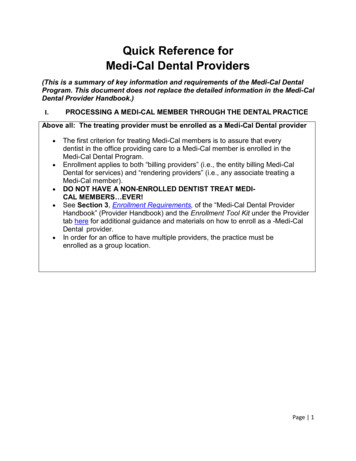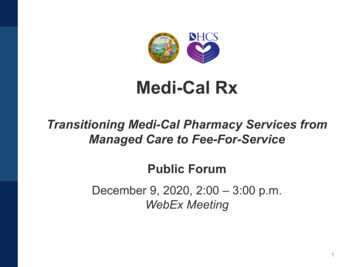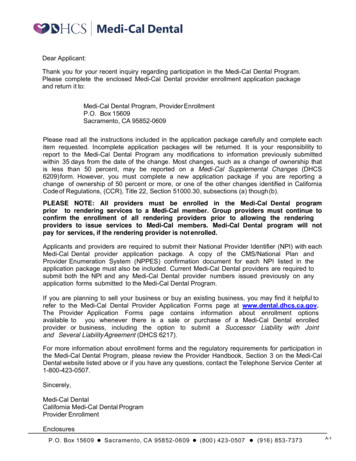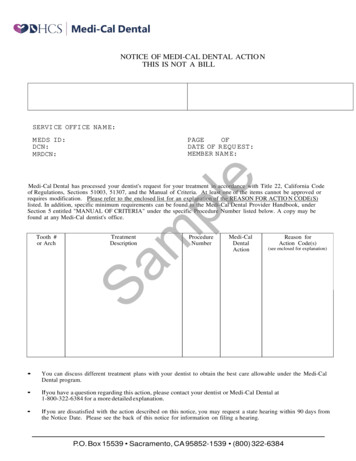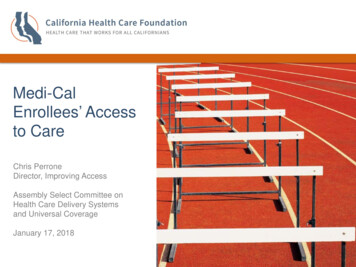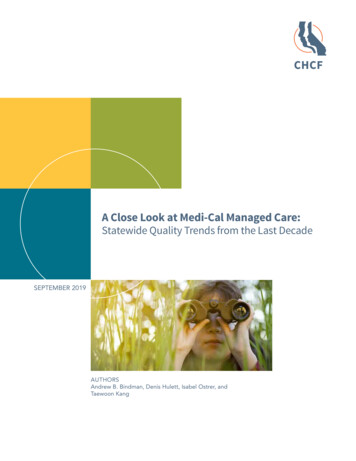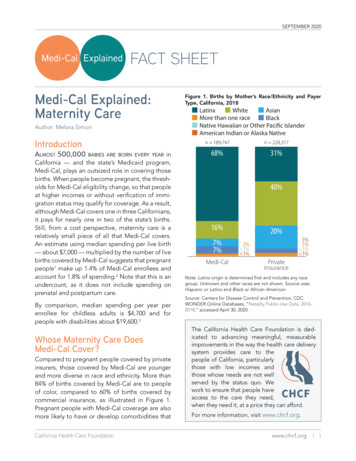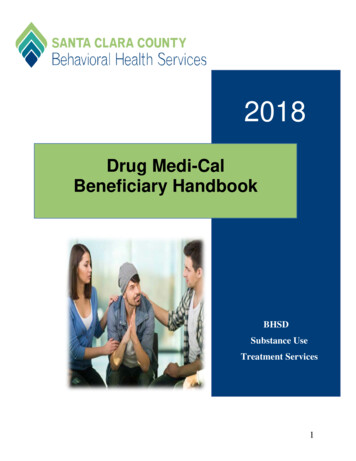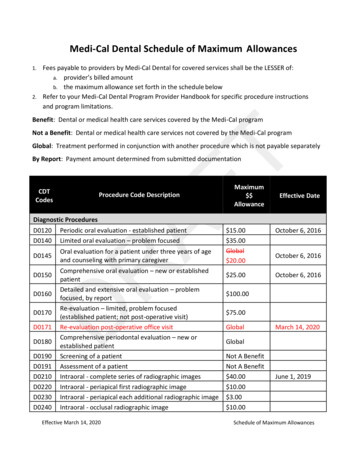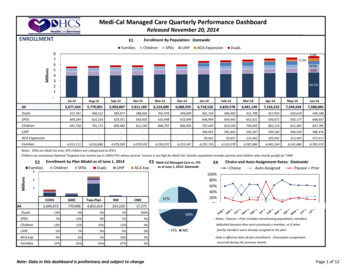
Transcription
Medi-Cal Managed CareAdvisory Group MeetingJune 9, 2022 – (Webex Only)Webex Event Number (Access Code): 2591 039 9208Event Password: MCAG*Join by Phone: 1-415-655-0001 US TollAccess Code: 2591 039 9208June 2022
»»»»Welcome and IntroductionsAgendaPublic Health Emergency Unwinding – Communication StrategiesBehavioral Health Integration (BHI) Incentive ProgramManaged Care Updates:» Updates for Dual Populations» Cal AIM Updates including Enhanced Care Management and Community Supports» Student Behavioral Health Incentive Program» Incentive Payment Plan (IPP)» Anthem Blue Cross» Santa Clara Family Health Plan» Non-Emergency Medical Transportation (NEMT) and Non-Medical Transportation (NMT)» Gender Affirming Postcards» Providing Access and Transforming Health (PATH) Updates» Open Discussion» Next Meeting: September 8, 2022
Welcome and Introductions
Public Health EmergencyUnwinding – CommunicationStrategiesYingjia HuangAssistant Deputy Director, Health Care Benefitsand Eligibility
PHE Unwinding:Resuming Medi-Cal Redeterminations» DHCS is committed to maximizing continuity of coverage for Medi-Calbeneficiaries through the course of the PHE unwinding period as the Departmentworks with local county offices to resume normal eligibility operations.» A key goal is to keep the PHE unwinding process as simple as possible.» When the continuous coverage requirement expires, CMS guidance provides thatstates will generally have up to 14 months to return to normal eligibility andenrollment operations.» To simplify the complexity of the PHE unwinding process, DHCS will maintain theMedi-Cal beneficiaries’ current renewal month in their case records and conducta full redetermination at the next scheduled renewal month following the end ofthe PHE.
Transitions to Covered California»Once the PHE ends, many Medi-Cal and Children’s Health InsuranceProgram (CHIP) beneficiaries may become ineligible and move to CoveredCalifornia. Currently, DHCS and Covered California are collaborating toimplement Senate Bill (SB) 260 (Chapter 845, Statutes of 2019) whichauthorizes Covered California to enroll individuals in a qualified healthplan when they lose coverage in Medi-Cal, the Medi-Cal Access Program(MCAP), and the County Children’s Health Initiative Program (CCHIP) andgain eligibility for financial assistance through Covered California.»The auto-plan selection program is anticipated to launch once the PHEends and will seamlessly transition individuals into Covered Californiaonce Medi-Cal discontinuances resume at the conclusion of the PHE.
DHCS Coverage Ambassadors» Top Goal of DHCS: Minimize beneficiary burden and promotecontinuity of coverage for beneficiaries» How you can help:» Become a DHCS Coverage Ambassador» Download the Outreach Toolkit on the DHCS Coverage Ambassadorwebpage» Join the DHCS Coverage Ambassador mailing list to receive updatedtoolkits as they become available» Medi-Cal COVID-19 PHE Operational Unwinding Plan releasedMay 17, 2022
DHCS PHE Unwind CommunicationsStrategy»Phase One: Encourage Beneficiaries to Update Contact Information.» Already launched.» Multi-channel communication campaign to encourage beneficiaries to updatecontact information with county offices.» Flyers in provider/clinic offices, social media, call scripts, and website banners.»Phase Two: Watch for renewal packets in the mail. Remember toupdate your contact information.» Launch 60 days prior to COVID-19 PHE termination.» Remind beneficiaries to watch for renewal packets in the mail and updatecontact information with county office if they have not done so yet.
Behavioral Health IntegrationIncentive ProgramSa NguyenHealth Program Specialist II, Managed CareQuality and Monitoring
Program Objectives»The Behavioral Health Integration (BHI) Incentive Program is designed toincentivize improvement of physical and behavioral health outcomes, caredelivery efficiency, and patient experience while aiming to continueintegration activities after the end of the program.»The goal of the BHI Incentive Program is to:» Increase managed care plan (MCP) network integration for providers atall levels of integration (those just starting behavioral health integrationin their practices as well as those that want to take their integration tothe next level).» Focus on new target populations or health disparities.» Improve the level of integration or impact of behavioral and physicalhealth.
Project Options» 3.1 Basic BHI» 3.2 Maternal Access to Mental Health and Substance Use DisorderScreening and Treatment» 3.3 Medication Management for Beneficiaries with Co-occurring ChronicMedical and Behavioral Diagnoses» 3.4 Diabetes Screening and Treatment for People with Serious MentalIllness» 3.5 Improving Follow-Up after Hospitalization for Mental Illness» 3.6 Improving Follow-Up after Emergency Department Visit for BehavioralHealth Diagnosis
Overview» Proposition 56 allocated 190 million to the BHI IncentiveProgram.»The awardee list was posted on the BHI webpage on April 9, 2021.» The awardee list is a point in time snapshot of the voluntary participation byMCPs and providers» 22 MCPs participating in 57 counties» 129 providers implementing 374 projects» The program period consists of:» Program Year 1 (January 1, 2021 – December 31, 2021) and» Program Year 2 (January 1, 2022 – December 31, 2022)
Program Year 1 Project ImpactProgram Year 1 ral Coast10391073Central646685Bay Area0200400600800Completed Milestones1000Milestones120014001600
Program Year 1 Payment ScheduleReportReporting PeriodPayment SchedulePY1-Qrt101/01/21 – 03/31/21September 2021PY1-Qrt204/01/21 – 06/30/21December 2021PY1-Qrt307/01/21 – 09/30/21April 2022PY1-Qrt410/01/21 -12/31/21Expected June 2022
Performance Measures» Measurement Year (MY) 2020 baseline data is required reportingand was due to DHCS by August 27, 2021. MY2019 is optionalreporting.» 2021 Program Year 1 Performance Measure Annual Report wasdue to DHCS by March 31, 2022.» For data not previously reported on, MCPs will establish MY2021as their baseline. MY2021 Baseline data is due August 27, 2022.» 2022 Program Year 2 Performance Measure Annual Report is dueMarch 31, 2023.
Next Steps» Milestone Invoice and ReportingReportReporting PeriodDue DatePY2-Qrt101/01/22 – 03/31/2205/30/22PY2-Qrt204/01/22 – 06/30/2208/29/22PY2-Qrt307/01/22 – 09/30/2211/29/22PY2-Qrt410/01/22 – 12/31/2203/01/23Reporting PeriodDue Date» Performance MeasuresReportMY2021 Baseline01/01/21 – 12/31/21 08/26/222022 Program Year01/01/22 – 12/31/22 03/31/2023
Thank You and Resources» VBP BHI IncProApp.aspx» Email Address: DHCS-BHIIPA@dhcs.ca.gov
Managed Care Updates forDual PopulationsAnastasia DodsonDeputy DirectorOffice of Medicare Innovation and IntegrationCalifornia Department of Health Care Services
Medicare Medi-Cal Dual Eligibles» 1.6 million individuals with both Medicare and Medi-Calcoverage in California, out of 6.6 million total Medicarebeneficiaries in the state.» Dual eligibles have higher rates of chronic conditions, higherutilization, social drivers of health, and lower quality measurescores. They must also navigate between two health programsand multiple delivery systems.» Integrated care programs for dual eligibles address thespecialized needs of these patients.
2023 CalAIM Policies related to DualEligible Beneficiary Enrollment» Mandatory Medi-Cal managed care enrollment for duals, statewide,effective January 2023 (currently effective in Coordinated Careinitiative (CCI) and County Organized Health System (COHS) countiesalready).» Long-term care (LTC) carve-in to Medi-Cal managed care, statewideeffective January 2023 (currently effective in CCI and COHS countiesalready).» Establishment of Exclusively Aligned Enrollment (EAE) Dual SpecialNeeds Plans (D-SNPs) and Cal MediConnect (CMC) transition,effective January 2023.
2023 Cal MediConnect Transition» CMC is a federal demonstration in 7 large counties and combines Medicare andMedi-Cal benefits in one health plan for integrated care.» On January 1, 2023, beneficiaries in CMC plans will be automatically transitionedinto exclusively aligned D-SNPs and MCPs operated by the same parentcompany as the CMC plan.» There will be no gap in coverage.» Provider networks should be substantially similar.» Continuity of care provisions for Medicare providers.» Beneficiaries will begin to receive notices from their CMC plan about thetransition starting in October 2022.» Beneficiaries will continue to have the choice to voluntarily enroll in the Medicarecoverage of their choice, including Original Medicare, Medicare Advantage (MA)plans, D-SNPs, Program of All-Inclusive Care for the Elderly (PACE).
Dual Eligible Special Needs PlanDefinition» D-SNPs are Medicare Advantage (MA) health plans that providespecialized care for dual eligible beneficiaries.» D-SNPs must have a State Medicaid Agency Contract (SMAC)with the state Medicaid agency, DHCS, in California.» DHCS can choose whether to contract with specific D-SNPs.» EAE D-SNPs are integrated with Medi-Cal. These types of planswill be in seven counties in 2023, and expanding to morecounties in future years.
Integrated Care Coordination &Materials» Enrollment in EAE D-SNP and the Medi-Cal MCP ownedby the same parent organization will allow similarintegration and care coordination as members in CCIcounties saw in CMC.» For example, integrated member materials and coordinationacross Medicare and Medi-Cal benefits and services.» Integrated materials are a benefit of EAE D-SNPs. DHCSis working closely with CMS on their development.
Integrated Grievances & Appeals» In 2024, EAE D-SNPs will also be required to provideintegrated grievances and appeals at the health planlevel. This is currently a requirement for CMC plans.» For appeals, this allows members to be notified of allapplicable Medicare and Medi-Cal appeal rightsthrough a single notice.
Medi-Cal Matching Plan Policy for DualEligibles - Key Principles» Medicare is the lead plan.» Dual eligible beneficiaries who are enrolled in a Medicareproduct must be enrolled in a matching Medi-Calmanaged care plan, if one is available.
2022: Matching Plan Policy» In 2022 and ongoing, in the 12 “matching plan” counties,Medicare plan choice determines Medi-Cal plan at theMedi-Cal prime level.» Non-CCI: Alameda, Contra Costa, Fresno, Kern, Sacramento, SanFrancisco, and Stanislaus counties.» CCI: Los Angeles, Riverside, San Bernardino, San Diego, and SantaClara counties.» In all other counties aside from the 12 counties (including COHS,non-COHS, non-CCI), there is no Medi-Cal matching plan policy.
2023: Matching Plan Policy» In 2023, in CCI counties, Medi-Cal plan alignment withMedicare choice extends to Medi-Cal delegate plans with fullrisk for all Medi-Cal managed care benefits.» In 2023, in the remaining non-CCI counties (Alameda, ContraCosta, Fresno, Kern, Sacramento, San Francisco, and Stanislauscounties), aligned enrollment will continue at the Medi-Calprime level.
LTC Carve-InGoal: Make coverage of institutional LTC consistent across all counties andmembers.» Medi-Cal MCPs in all counties will cover LTC benefit for following facilitytypes:» January 2023: Skilled Nursing Facility (SNF), including a distinct partor unit of a hospital (estimated 28,000 beneficiaries);» July 2023: Subacute» Subacute Facility;» Pediatric Subacute Facility.» July 2023: Intermediate Care Facility (ICF);» Intermediate Care Facility for Developmentally Disabled (ICF-DD);» ICF-DD/Habilitative;» ICF-DD/Nursing.
Guiding Principles for LTC Carve-In» Transition should be seamless for members» No disruption in access to care or services» MCPs conduct timely review and authorization of services» Ensuring Continuity of Care» Provide timely data to plans to guide contracting and facility/memberoutreach» Require plans and facilities to coordinate through transition to supportmembers
Topics to Address in Policy Guidance» Separate All Plan Letters for each facility type» Three APLs: SNFs, Subacute, ICF-DDs» SNFs to be released this month» Continuity of Care» Network Adequacy» Directed payment policy» Operational guidance including» Leave of Absence and Bed Hold,» Care Management policies already included in MCP contracts
CalAIM: Enhanced Care ManagementCommunity SupportsNeha ShergillStaff Services Manager II, Managed CareQuality and Monitoring
ECM and Community Supports» Updated ECM Policy Guide» Updated ECM LTC-related Populations of Focus definitions» Updated ECM Policies for dual eligible members in 2023 andBeyond» Newly Added ECM and Community Supports FAQs» Updated ECM and Community Supports Model of Care (MOC)template submission process
ECM and Community SupportsECM Implementation Timeline Individuals Transitioning From Incarceration statewide: TBC as more information available
Updates to the ECM & Community SupportsMOC Template Submission Process34
MOC Template Submission Process: What’s Changed?» The process for MOC submissions is changing.» Moving forward, MCPs are required to submitupdates and changes to ECM and CommunitySupports material via separate MOC templatesubmissions.35
MOC Template Submissions: DeadlinesSpringFallSummerWinter2022» ECM MOCAddendum I forJanuary 2023Populations ofFocus publishedMay 27th» CommunitySupports MOCTemplatepublished May27thWinter2023» ECM MOCAddendumfor January2023Populationsof Focus dueto DHCS July 5» ECM MOCAddendum re:ProviderNetwork dueto DHCSSeptember 1» CommunitySupportsMOC due toDHCS July 5(every 6months)» CommunitySupportsMOC re:ProviderNetwork dueto DHCSSeptember 1» CommunitySupportsMOCQuestions dueto DHCSDecember 31(every 6months)» ECM Live forNewPopulations ofFocus (LTC &Nursing HomeResidents) onJanuary 1DHCS will release another MOC template addendum in fall 2022 with submission instructions and questionspertaining to the Individuals Transitioning from Incarceration and Children and Youth Populations of 36Focus.
Looking Ahead37
CalAIM Updates – Webinars and Upcoming riesSobering Centers andDay HabilitationAsthma Remediation &EnvironmentalAccessibility AdaptationsShort-Term PostHospitalization &Recuperative CareWednesday, July 20th12:00 – 1:00 PM PTThursday, August 18th1:00 – 2:00 PM PTRegister hereRegistration link forthcomingA New Vision for WholePerson CareSupporting RuralProvidersIntersection of ECM &Community SupportsThursday, June 2nd10:30 AM – 12:00 PM PTTuesday, June 14th11:30 AM – 1:00 PM PTTuesday, June 21st10:00 – 11:30 AM PTSlides available hereRegistration linkforthcomingRegistration link forthcomingWednesday, June 15th1:00 – 2:00 PM PTRegister here
Upcoming 2022 MCP MilestonesPopulation Health Management (PHM), ECM, Community Supports,IPP & Homelessness Incentive Program, and PATH Supports» PHM Launch/ PHM Service Test Launch withJuly 1,Multiple Partners2023» ECM Additional Adult Populations of Focus Launch» Community Supports Implementation PhaseJan 1,2023Date*Q3Initiative» ECM Children/Youth Launch» PHM Service Statewide Launch & Scaling» Community Supports ImplementationPhaseMilestone7/1ECM & Community » ECM Go-Live (non-WPC/HHP Counties)» New Community Supports Elections (every 6 months)Supports7/5ECM & Community» MOC updates dueSupportsJulyPATH8/15» Application period for Round 1 of Justice-Involved Planning andCapacity Building Initiative closes» Application period for Round 2 of Justice-Involved Planning and CapacityBuilding Initiative opensECM & Community» Quarterly Implementation Report DUE (2022 Q2)Supports*Dates are subject to change with notice by DHCS39
ContinuedDate*Q3InitiativeMilestoneAugustPHM» 2023 PHM Program Guide and 2023 PHM Strategy Readiness DeliverableTemplate released9/1ECM CM &CommunitySupports» ECM Policy Guide updated to include guidance about POFs that Go-Livein July 20238/15ECM &CommunitySupports» Quarterly Implementation Report DUE (2022 Q2)Q3PATH» MOC updates due» MCP Program Year 1 Submission 2 due to DHCS» Initial payment issued to MCPs» Initial launch and application windows for Collaborative Planning andImplementation, Capacity and Infrastructure Transition, Expansion, andDevelopment, and Justice-Involved Planning and Capacity BuildingInitiatives*Dates are subject to change with notice by DHCS40
Upcoming 2022 MCP Milestones (2)PHM, ECM, Community Supports, IPP, Housing & Homelessness Incentive Program, and PATH SupportsJan 1, 2023 » PHM Launch/ PHM Service Test Launch with Multiple July 1, 2023 » ECM Children/Youth Launch» PHM Service Statewide Launch & ScalingPartners» ECM Additional Adult Populations of Focus LaunchDate*Oct.11/14Q4InitiativePHMMilestone» MCPs MCP 2023 PHM Readiness Submission dueECM & Community» Quarterly Implementation Report DUE (2022 Q3)SupportsNov.PHM» 2023 Supplemental Reporting Guidance for PHM publishedDec.PHM» Amended APLs regarding IHEBA/SHA and Individual Health Assessmentreleased, which include but are not limited to, APL 08-003, APL 13-001, APL13-017Dec.Q4Incentive Payments » Second Incentive Payment paid to MCPs» Preliminary launch of Technical Assistance MarketplacePATH» Application period for Round 2 of Justice-Involved Planning andCapacity Building Initiative closes41*Dates are subject to change with notice by DHCS
Student Behavioral HealthIncentive ProgramLisa RischHealth Program Specialist II, Managed CareQuality and Monitoring
SBHIP OverviewQUICK FACTSWho: Medi-Cal (MCPs) will partner with:» Local Educational Agencies (LEA)» County Offices of Education (COE)» County Behavioral Health PlansAuthority: AB 133, Welfare & InstitutionsCode Section 5961.3What: A voluntary program that will makeincentive payments to MCPs that meetpredefined goals and metrics.Focus Area: TK-12When: January 2022 – December 2024Amount: 389 million43
SBHIP Goals»»»»Break down silos and improving coordinationStrengthen relationshipsBuilding capacity and infrastructureIncrease number of TK-12 students receiving preventive and earlyintervention BH services44
SBHIP Duration and SustainabilitySBHIP Design Period(August 2021–December 2021)SBHIP ImplementationPeriod (January 2022–December 2024)Post-SBHIP (January2025 and beyond)45
SBHIP TimelineSBHIP TimelineDate / Deadline1.Letters of Intent: MCP Letters of Intent due to DHCSJan 31, 20222.Identify Partners: MCPs work with the COE to select collaborative partners andtarget student population and submit information to DHCSMar 15, 20223.Intent to Submit Accelerated Project Plan (Milestone One): MCPs indicate intent Apr 1, 2022to submit accelerated Project Plan (Milestone One) and implement targetedinterventions in 20224.OPTIONAL: Accelerated Project Plan (Milestone One): MCPs develop and submit Jun 1, 2022accelerated Project Plan(s) for each targeted invention and each county to DHCS5.DHCS reviews and approves accelerated MCP project plan for each MCP and eachtargeted intervention for each countyAug 31, 20226.County Needs Assessment: MCPs conduct Needs Assessment and submits toDHCSDec 31, 20227.Project Plan (Milestone One): MCPs develop and submit Project Plan(s) for eachtargeted invention and each county to DHCSDec 31, 202246
SBHIP TimelineSBHIP TimelineDate / Deadline8.DHCS reviews county Needs Assessment package, requests additional informationas needed, and approves Needs Assessment packageFeb 28, 20239.DHCS reviews and approves MCP project plan for each MCP and each targetedintervention for each countyFeb 28, 202310. Bi-Quarterly ReportBi-Quarterly11. Project Outcome Report (Milestone Two): MCPs submit project outcomes foreach targeted intervention for each CountyDec 31, 202412. SBHIP operations closeDec 31, 202447
SBHIP Deliverables» Needs Assessment (12-31-2022)» Project Plans (12-31-2022)» Bi-Quarterly Reports (2023-2024)» Project Outcome Reports (12-31-2024)48
SBHIP Findings (as of 6/1/22)CategoryPreliminary Findings*1.County Coverage23 MCPs, covering 58 of 58 counties2.COE Partnerships57 of 58 counties3.MCP PartnershipsMCPs are partnering in all 46 counties where multiple MCPs operate4.LEA Partnerships306 LEA Partners (exceeds minimum 10 percent requirement)5.County BehavioralHealth Partnerships57 of the 58 counties*Note: SBHIP partnership information is subject to change given MCPs are still formulating theirapproaches.49
SBHIP will Enhance Coordination and CollaborationAmong Medi-Cal MCPs, County BH, and LEAs/SchoolsSBHIP Roles and Responsibilities:MCPsCollaborate with DHCS, COEs, LEAs, County Behavioral Health, and other stakeholders to:» Perform county-level needs assessment to determine gaps, disparities, and inequities» Coordinate the design and implementation of targeted interventions» Develop MOUs with selected partners» Report SBHIP project status and project impact to DHCSCOEsCollaborate with DHCS, MCPs, LEAs, County Behavioral Health, and other stakeholders to:» Help MCPs select collaborative partners and student population(s)» Assist with required county-level needs assessment activities, as appropriate» Address project-related implementation questions, as appropriate» Sign MOUs with MCP partnersCountyBHCollaborate with DHCS, MCPs, LEAs, and other stakeholders to:» Assist with required county-level needs assessment activities, as appropriate» Address project-related implementation questions, as appropriate» Sign MOUs with MCP partnersSource: SBHIP Overview and Requirements
SBHIP TA Resources1. SBHIP Office Hours:Every 2nd Tuesday of the month3:00-4:00 pm PDTMicrosoft Teams meetingJoin on your computer or mobile appClick here to join the meetingOr call in (audio only) 1 323-457-5649,,756199933#Phone Conference ID: 756 199 933#Every 4th Thursday of the month9:00-10:00 am PTMicrosoft Teams meetingJoin on your computer or mobile appClick here to join the meetingOr call in (audio only) 1 323-457-5649,,366823085#Phone Conference ID: 366 823 085#If you would like to receive a standing calendar invitation for these office hour sessions, please emailJackie Yim (hyim@guidehouse.com) and she will add you to the invitation2.3.4.5.SBHIP Deliverables Mailbox: Email questions and deliverables to SBHIP@dhcs.ca.govSBHIP TA Mailbox: Email TA questions to SBHIP@guidehouse.comSBHIP Webpage: ntiveprogramIndividualized TA Support: Available upon request, please reach out to the SBHIP mailbox51
Incentive Payment PlanDana DurhamDivision Chief, Managed Care Qualityand Monitoring
About IPPThe CalAIM Incentive Payment Program (IPP) is intended to support theimplementation and expansion of Enhanced Care Management (ECM) andCommunity Supports by incentivizing managed care plans (MCPs), in accordance with42 CFR Section 438.6(b), to:» Drive MCP delivery system investment in provider capacity anddelivery system infrastructure.» Bridge current silos across physical and behavioral health care servicedelivery.» Reduce health disparities and pro mote health equity.» Achieve improvements in quality performance.» Encourage take-up of Community Supports.53
IPP Program Year 1 TimelineIn January, MCPs submitted their first responses to IPP and received initial paymentsin April. Since then, the Department has solicited feedback on the Submission 1process and content to inform updates to the second submission of PY1, which willbe released in early June.2022Q1JFQ2M(Jan)Sub. 1Responses DueASub. 1PaymentIssuedQ3MJReviewSub. 1FeedbackJA(Early Jun) ReleaseSub. 2 MaterialsTodayQ4SO(Early Sep)Sub. 2ResponsesDueND(Nov)MCQMDS2 Eval. Sub. 2Decisions PaymentSent toIssuedCRDD54
Program Year 1 PaymentsFor PY1 (CY 2022), DHCS is following a bi-annual payment cycle to issue 600M to MCPs.Submission 1: April 2022 Payment» DHCS issued 50 percent of available PY1 dollars ( 300M)» Payments are tied to the completion of requirements related to assessing needs,identifying gaps and strategic planning efforts» Submission 1 was completed and reported on in January 2022» Submission 1 funds are subject to recoupment based on successful completion of andperformance against certain Submission 2 measuresSubmission 2: December 2022 Payment» DHCS will issue 50 percent of available PY1 dollars ( 300M)» Payments are tied to the completion of progress measures, which aim to measureprogress against gap-filling goals outlined in Submission 1» Submission 2 materials will be submitted by MCPs in September 2022 and based onactivity from January through June 202255
MCP Performance & PaymentsMCP payment is based on the successful completion of and performance against IPP measures.Priority AreaMandatory MeasuresOptional MeasuresMCP Discretionary(Quality Priority AreaAllocations#4)1. Delivery SystemInfrastructureUp to 200 pointsNoneUp to 300 points2. ECM Provider CapacityBuildingUp to 170 pointsUp to 30 points3. Community Supports(ILOS) Provider CapacityBuilding and CommunitySupports (ILOS) Take-UpUp to 250 pointsUp to 50 pointsMCPs may allocate pointsacross Priority Area 1-3.Discretionary points areearned proportionatelybased on performance.For example, if a MCPallocates 100 points toPriority Area 1 and earns90% of the Priority Area 1points, it will earn 90 ofthose 100 discretionarypoints.Category Totals Up to 620 pointsUp to 80 pointsUp to 300 pointsTOTAL Up to 1,000 points56If an MCP achieves only a subset of these points, it will earn a partial payment.
IPP Priority AreasMCPs that elect to participate in the IPP must meet requirements set forth in thereporting template, which includes measures in each of the following priority areas:1. Delivery SystemInfrastructure2. ECM Provider CapacityBuildingFund core MCP, ECM andCommunity SupportsProvider HIT, and dataexchange infrastructurerequired for ECM andCommunity SupportsFund ECM workforce,training, TA, workflowdevelopment, operationalrequirements andoversightMCPs are required to report on aminimum number of optional measures3. Community SupportsProvider Capacity Building &MCP Take-UpFund Community Supportstraining, TA, workflowdevelopment, operationalrequirements, take-up andoversight4. QualityOptional measures with a set number of points allocated toPriority Areas 2-3 (ECM/Community Supports Capacity Building)57
Submission 1: Overview & GoalsComponents» Needs Assessment: Baseline dataabout the status of delivery systeminfrastructure, ECM and CommunitySupports provider capacity, andCommunity Supports take-up.» Gap-Filling Plan: Narrative thatoutlines MCPs’ approaches toaddressing gaps identified in theNeeds Assessment. MCPs areexpected to work closely with localpartners to develop, vet, and iterategap-filling plans.Goals» Landscape: Provide a “point in time”understanding of the ECM andCommunity Supports infrastructure priorto launch. This landscape assessment isthe baseline to measure programmaticgrowth.» Strategic Planning: Create a commonframework across MCPs and counties tofacilitate long-term, sustainable planning.» Collaboration: Establish collaborativerelationships for MCPs and local partners.58
Submission 1: Trends» Overall MCPs provided concrete steps to address workforce and TA needs, includingsharing assessments or meeting with their contracted providers.» Most MCPs kept most of their overall points in the Community Supports ProviderCapacity priority area.» Overall commercial MCPs focused their discretionary points on ECM and CommunitySupports, while MCPs in single-plan counties tended to focus on delivery infrastructure.» Many plans in former Whole Person Care (WPC) counties expressed they have providercapacity to meet the demand for Community Supports, specifically for housing-relatedCommunity Supports and medically-tailored meals.» Capacity to meet the demand for ECM was varied, even across MCPs operating in thesame counties.59
IPP: Important DatesJune 3: Received feedback on Submission 2 updatesJune 10: Submission 2 materials releasedJune 10: Submission 2 TA webinar (Registration Required)September 1: Submission 2 responses due60
Anthem Blue CrossCalAIM Incentive PaymentProgramBeau HennemannAnthemDirector, Special Programs
Anthem Blue Cross – IPP Goals»»Support long-term capacity and sustainability»»»Prioritize investments to close gaps related to health equity/disparitiesAllocate funds based on local priorities» Support contracted and potential ECM and Community Supports (CS) providers» Support county/community infrastructure development» Prioritize partners who are committed to building long-term partnershipsSupport needs that align with DHCS-developed incentive measuresSupport partners in identifying alternate funding sources when applicable
IPP Gaps and ProgressIdentifyingGaps/Needs»»»»»»1:1 provider engagementECM/CS provider readiness assessmentsData/network analysisCounty collaborationsCross-plan stakeholder/roundtable meetingsOn-going gap identificationCurrentProgress»»»»»»Baseline measures completed and initial funds awarded to MCPsProgram design developedMCP joint application process developedConsultants engaged to help facilitate/coordinate across plansRound 1 applications received in MayAwards determined/funds distributed in July
Santa Clara Family Health PlanCalAIM Incentive PaymentProgramLori AndersenDirector, Long-Term Services andSupports (LTSS)
Introduction»Santa Clara Family Health Plan (SCFHP):» Enrolled its first members in 1997 – 25 years» Medi-Cal managed care membership - 271,000» Network of 19 ECM and 11 Community Supports providers, with 10 contracted toprovide both ECM and Community Supports» Offering 5 Community Supports – Housing Navigation, Housing Deposits, NursingFacility Diversion/Transition to Residential Care Facilities for the Elderly (RCFEs),Nursing Facility Transition to Home, Medically Tailored Meals/Supportive Food» Launched with 5,500 members either enr
Medi-Cal Managed Care Advisory Group Meeting June 2022. June 9, 2022 - (Webex Only) Webex Event Number (Access Code): 2591 039 9208. Event Password:
